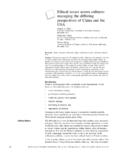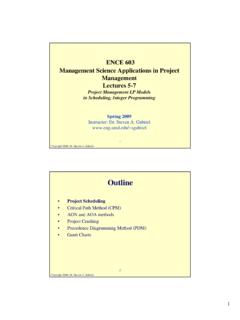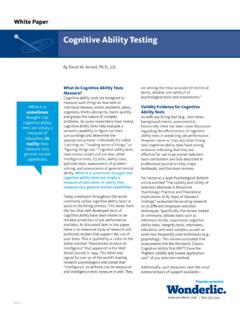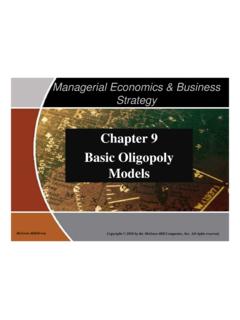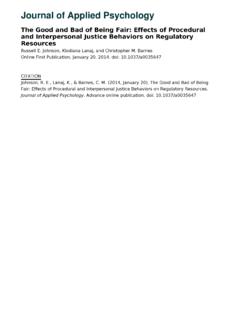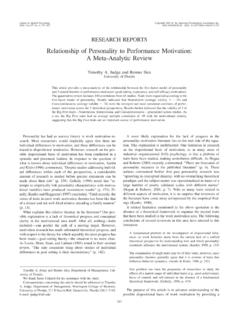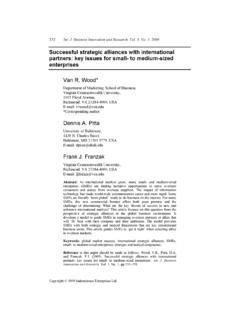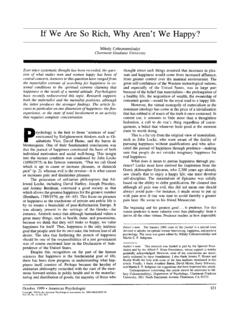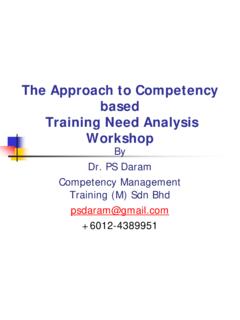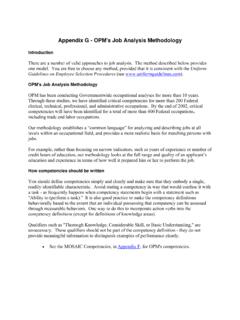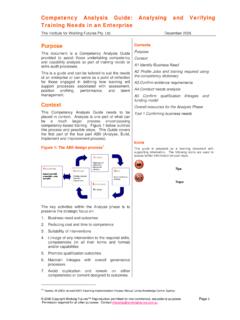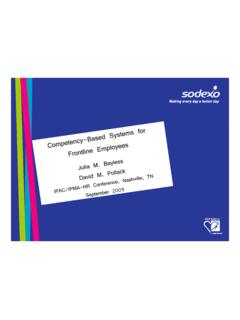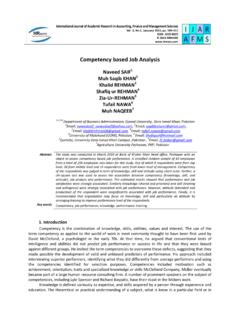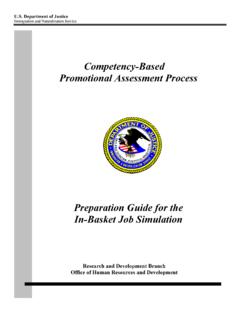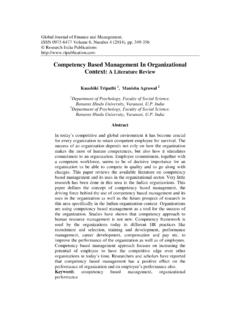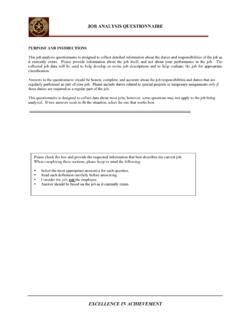Transcription of Competency Modeling & Job Analysis - ubalt.edu
1 Competency Modeling & Job Analysis 1 Competency Modeling & Job Analysis Current trends and debates in the academic literature The current report details the state of the academic literature on Competency Modeling and job Analysis . The paper begins by providing definitions of competencies, Competency Modeling , and job Analysis . The next section summarizes current trends in the literature on Competency Modeling and job Analysis . The final section uncovers some current debates in the Competency Modeling and job Analysis literatures. Definitions Competencies: Although the definition appears to vary widely (Schippmann, et al., 2000), competencies are typically defined as a combination of knowledge, skills, abilities and other individual characteristics (often called KSAOs; including but not limited to motives, personality traits, self-concepts, attitudes, beliefs, values, and interests) that can be reliably measured and that can be shown to differentiate performance (Mirabile, 1997; Schippmann, et al.)
2 , 2000; Spencer, McClelland, & Spencer, 1994). Competency Modeling : Competency Modeling is typically defined as the identification, definition, and measurement of the KSAOs that are needed to perform successfully on the job (Bartram, 2004; Schippmann, et al., 2000). Competency Modeling can be carried out using a few different approaches, but the most common are the individual job level and the organization level (Mansfield, 1996). The former deals with identifying the characteristics ( , KSAOs) that are necessary to be successful in a particular job (often referred to as a bottom-up Competency model, and is quite similar to job Analysis ), whereas the latter takes into account organizational objectives, vision, and strategy and attempts to develop a set of competencies that are applied to the entire organization, a department within the organization, or a job family within the organization (Lawler, 1994; Prahalad & Hamel, 1990).
3 Job Analysis : Broadly defined, job Analysis involves collecting data about observable job behaviors, and delineating the knowledge, skills, abilities, and other characteristics needed to perform the job (Cascio & Aguinis, 2005; Harvey, 1991). This broad definition is typically broken into two separate approaches to job Analysis : worker-oriented job Analysis and task-oriented job Analysis . Worker-oriented job Analysis is often referred to as job specification and deals with the necessary KSAOs for successful completion of the job. As one can see, this is very similar in nature to the definition of Competency Modeling advanced above. The other approach is referred to as task-oriented job Analysis (also called work-oriented), and deals with what gets done on the job ( , the job relevant behaviors) and how the job is conducted (including the tools, machinery, information, and people with which the incumbent typically interacts).
4 This approach is often referred to as a job description, as it details the necessary behaviors for successful completion of the job (Cascio & Aguinis, 2005). Competency Modeling & Job Analysis 2 Recent trends in Competency Modeling and job Analysis Automation of Competency Modeling /job Analysis The use of technology is changing the nature and execution of many areas of human resource practice ( , online assessments; Bartram, 2004). In an effort to streamline and make the process of Competency Modeling /job- Analysis more efficient, Mason and Lin (2008) advocate the use of online data warehouses of Competency models, web-based focus groups, and the use of online surveys to gather data from subject matter experts (SMEs) and incumbents. Others have utilized an online database of job information called the Occupational Information Network (O*NET) for the purpose of gathering position requirements and determining common tasks ( , McEntire, Dailey, Osburn, & Mumford, 2006; Reiter-Palmon, Brown, Sandall, Buboltz, & Nimps, 2006).
5 The implementation of these methods may have drawbacks, including the inability to detect and account for cultural differences, the lack of access to technology in certain areas of the world, and the inability to apply the pre-made models to specific jobs. Mason and Lin make some important recommendations for other practitioners who choose to implement job Analysis or Competency Modeling using technology, including a great deal of planning in advance and ensuring that key stakeholders get involved. As Harvey (2008) points out, the automation of job Analysis and Competency Modeling has tremendous potential to make the process more affordable and practical, but warns of the problems ( , inaccuracy) associated with applying an average profile to a specific job. Strategic job Analysis Strategic job Analysis involves attempting to identify the relevant tasks, behaviors, and KSAOs for a job as they are predicted to be in the future (Schneider & Konz, 1989).
6 This approach represents a change from descriptive job Analysis (with a focus on describing the job as it currently exists) to predictive job Analysis (which focuses on how the job is expected to be in the future). The need for strategic job Analysis is becoming more apparent because of the dynamic nature of modern-day organizations (with a greater reliance on rapidly changing project teams) and as organizations try to hire, train, and appraise the performance of new positions (Sackett & Laczo, 2003; Sanchez & Levine, 2001). Despite the increased call for strategic job Analysis , very little research has been conducted on the topic, with most of the available literature on the topic being prescriptive in nature (with the exception of Arvey, Salas, & Gialluca, 1992; Bruskiewicz & Bosshardt, 1996) and focusing largely on how to carry out a strategic job Analysis ( , see Schneider & Konz, 1989).
7 The major findings from these few empirical studies suggest that strategic job Analysis may be able to successful identify future skill requirements. However, many questions remain, such as, how well can strategic job analyses predict successful performance? Cognitive task Analysis With the advent of the Internet and the great increase in technology across the workplace, today s jobs contain more cognitive complexity than ever before (Bartram, 2004). In an effort to best select and appraise the performance of today s workers, cognitive task Analysis (CTA), that is, the identification and Analysis of cognitive processes that underlie task performance, has been offered as a supplement to traditional task Analysis (Chipman, Schraagen, & Shalin, 2000; Sackett & Laczo, 2003). The effectiveness of CTA at Modeling the cognitive processes of jobs has recently been demonstrated in a large-scale meta- Competency Modeling & Job Analysis 3 Analysis of 39 studies, which used a pre- and post-test design to examine the impact of CTA on performance (Lee, 2004).
8 The results revealed a large overall effect size of when using any CTA method, in any occupational setting, with any level of employee experience. Lee points out that this large effect size ( ) translates to an overall mean percent gain in performance of 35%. Despite this optimistic finding, Sackett and Laczo (2003) point out that there is no as yet agreed upon method for conducting CTA, and the process is very time consuming and effortful. Both of these concerns seem to limit the usefulness of this approach in new occupational settings. However, recent work by Yates (2007) on the development of a taxonomy of CTA methods is encouraging. Future studies should aim to demonstrate the use of various cognitive task Analysis methods and how to use the data gathered from them in applied settings. Personality-oriented job analyses The use of personality as a predictor in selection is becoming more and more common in today s organizations (Cascio & Aguinis, 2003).
9 Countless meta-analyses have demonstrated that a number of broad personality traits (which are enduring styles of thinking, feeling, and acting that characterize individuals), namely conscientiousness and integrity, are associated with high performance on the job ( , see Barrick & Mount, 1991; Ones, Viswesveran, & Schmidt, 2003). There have been several efforts to identify personality requirements of jobs, with examples including the NEO Job Profiler (Costa, McCrae, & Kay, 1995), and the Personality-Related Position Requirements Form (PPRF; Raymark, Schmit, & Guion, 1997). Both of these approaches attempt to identify relevant personality dimensions for a particular job. Recent research using the PPRF by Cucina, Vasilopoulous, and Sehgal (2005) demonstrated that subject matter experts may be engaging in a self-serving bias to a small degree when rating the personality requirements of a job, but overall, their ratings were found to be predictive of scale scores on the PPRF.
10 Further research is needed to determine whether relevant personality dimensions are more predictive of job performance than less relevant personality dimensions. Overall, the incorporation of personality into job-analytic efforts is an important step toward better description of jobs, and organizations should continue to implement such approaches to benefit their personnel practices. Reliability of Competency Modeling and job- Analysis ratings An important part of any job Analysis or Competency Modeling effort involves having incumbents, subject matter experts, or the job analysts themselves rate the importance of each Competency , KSAO, task, or behavior statement. Ideally, these raters will agree with each other on the importance of these characteristics, demonstrating a high level of inter-rater reliability, and then the practitioner can move on in the process with their new list of statements.
